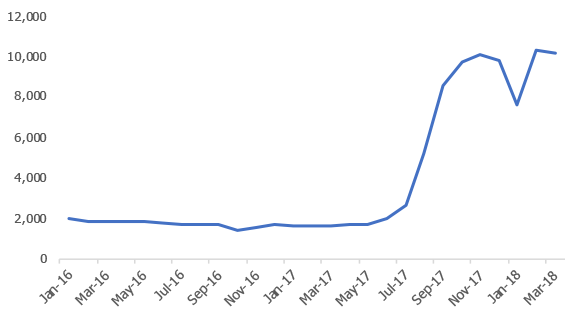Roskill notes that “batteries underpin growth in natural graphite.” Both synthetic and natural graphite compete for use in lithium-ion battery anodes, along with an increasing amount of needle coke and other existing carbon materials. Demand for graphite in battery applications is forecast to grow by 5-8% annually over the decade between 2017 and 2027. Roskill forecasts global sales of EVs and hybrid vehicles will increase rapidly in the coming years and could account for 69% of all motor vehicle sales by 2027.
The growing demand for spherical graphite has injected life into natural graphite supply chain development in the rest-of-world (ROW). The focus for developers is now to produce the highest ratio of fine to medium-size flake, most suited for spherical graphite.
The graph shows China: Average value of graphite and carbon electrode exports, suitable for use in furnaces ($/t) (Source: Global Trade Tracker)
China continues to dominate graphite production and demand. Almost all stages of the lithium-ion battery manufacturing chain are focussed on China and China is by far the largest and most rapidly growing market for lithium-ion batteries.
In the electrode industry, China is on the brink of a rapid shift to EAF steel production. Just 6% of China’s steel is currently produced in EAF, way below the global average of 25%.
Roskill’s assessment is that “high synthetic graphite prices in 2018 are the result of a perfect storm of conditions in China. Firstly, environmental plant closures in the raw material coal needle coke industry hampered the production of graphite electrodes. At the same time, consumption of graphite electrodes in electric arc furnaces (EAFs) began to rise as the Chinese government took steps to halt production of poor quality induction furnace steel.
Roskill’s Natural and Synthetic Graphite: Global Industry, Markets and Outlook to 2027 report was published in June 2018 and details natural and synthetic graphite production, consumption and market trends.











